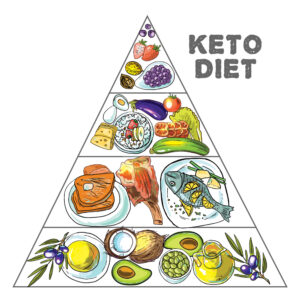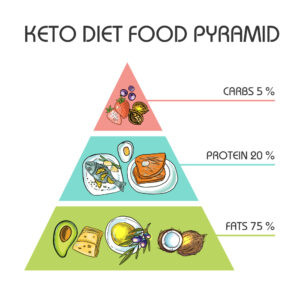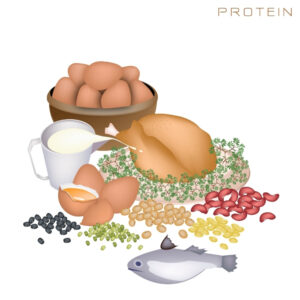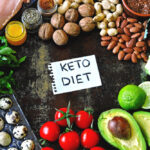1. Introduction:
everyone’s always searching for the perfect diet that gives them more energy and makes them healthier overall, not just helping them lose weight. Amongst various dietary approaches, one stands out for its versatility and effectiveness: the ketogenic diet, often named the “keto diet.”
This revolutionary approach to nutrition has gained immense popularity, especially among fitness professionals, owing to its unique metabolic mechanisms and promising outcomes. In this blog, we’ll delve deep into the secrets that fitness pros swear by when it comes to unlocking the full potential of the keto diet.
2. How Keto Diet Can Benefit Fitness Enthusiasts:

While there’s some controversy surrounding the keto diet’s impact on physical exercise, many fitness enthusiasts have experienced its benefits firsthand.
This section explores the advantages of the keto diet for individuals engaged in regular fitness activities, including weight loss, appetite control, muscle recovery, increased endurance, and overall health improvements.
3. Understanding the Keto Diet:
Before diving into the insider secrets, it’s crucial to grasp the fundamentals of the keto diet. At its core, the keto diet is a high-fat, moderate-protein, and low-carbohydrate eating plan designed to induce a metabolic state known as ketosis.
Ketosis occurs when the body shifts from relying on glucose as its primary fuel source to burning fat for energy. This metabolic switch not only facilitates fat loss but also offers a myriad of health benefits, including improved cognitive function and enhanced insulin sensitivity.
4. Go Back to the Basics: Low Carb, High fat, And Moderate Protein

The foundation of the keto diet lies in its fundamental principles: low-carb, high fat, and moderate protein. By adhering to these principles, individuals can initiate and sustain a state of ketosis, where the body shifts from using glucose as its primary fuel source to burning fat for energy.
Achieving the ideal macronutrient ratios is paramount for entering ketosis and maximizing fat burning. With a focus on low carb intake, ample healthy fats, and moderate protein consumption, the keto diet sets the stage for transformative results.
5. Consume Plenty of Healthy Fats:
Healthy fats serve as the cornerstone of the keto diet, providing a steady source of energy and essential nutrients. It’s crucial to prioritize quality sources of fats while steering clear of harmful trans fats.
Incorporating foods like avocados, nuts, seeds, and olive oil not only enhances satiety but also supports heart health and cognitive function. By embracing healthy fats, individuals can fuel their bodies efficiently and optimize their ketogenic experience.
6. Pay Attention to Your Protein Intake:

Protein plays a pivotal role in muscle growth, repair, and overall metabolic function. While protein is essential for supporting fitness goals, excessive intake can hinder ketosis by stimulating insulin secretion and gluconeogenesis.
Striking a balance between adequate protein intake and ketosis is key to maximizing fat burning while preserving lean muscle mass. By selecting lean protein sources and moderating portion sizes, individuals can achieve optimal results on the keto diet.
7. Have a Short Fasting or Fat Fasting:
Combining fat fasting or short fasting periods into your routine can speed up the transition into ketosis and increase fat burning. Fasting promotes metabolic flexibility, enabling the body to switch logically between ketones and glucose for fuel.
In addition, fat fasting, where calories are derived primarily from fats, can enhance ketone production and help overcome plateaus. Individuals can accelerate their keto journey and accumulate the benefits of metabolic adaptation, by compromising strategic fasting strategies.
8. Increase Your Physical Activities:
Regular physical activity cooperates with the keto diet to maximize metabolic health and enhance overall well-being. Exercise breaks down the glycogen stores, promoting the production of ketones and facilitating the alteration into ketosis.
Moreover, physical activity facilitates fat oxidation, increases insulin sensitivity, and improves cardiovascular function.
Movement into your daily routine enhances the effects of the keto diet and promotes acceptable fitness outcomes, whether it’s through strength training, cardiovascular exercise, or activities that can be recreational.
9. Focus on Low-Intensity Exercises:
It’s essential to give importance to low-intensity activities to maximize fat burning and endurance, while exercise is crucial to the keto journey. High-intensity exercises may contain performance on a low-carb diet due to confined glycogen availability.
Having a balanced approach to exercise complements the ketogenic lifestyle, enabling individuals to achieve their fitness ambitions while picking the rewards of improved vitality and health.
Without the need for carbohydrate addition, individuals can maximize metabolic efficiency, increase consumption of fat, and maintain energy levels, by paying attention to low-intensity exercises such as cycling, walking, or yoga.
10. Final Thought:
In the end, the keto diet, a low-carb alternative, holds vast potential for fitness professionals looking to improve their performance, health, and physique. T shares six important tips for maximizing the benefits of the keto diet.
It’s all about paying attention to your macros, eating mostly whole foods, staying in ketosis, keeping your electrolytes balanced and staying hydrated, exercising regularly, and having a positive mindset. Following these tips can help fitness enthusiasts reach their health goals with determination and confidence.





